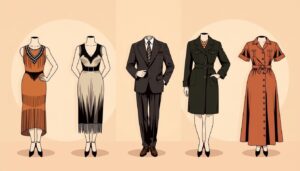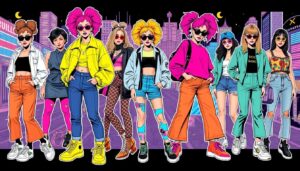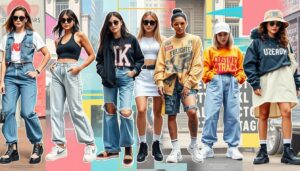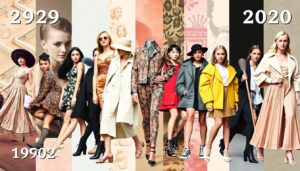The Evolution of Fashion Through the Decades. Throughout the long term, fashion has gone through a true change. The explanations behind this change incorporate political occasions, web-based entertainment, state-of-the-art advancements, as well as social trades. Understanding design fashion all through the years gives a brief look into how the business developed.
Fashion has changed fundamentally from the mid-1900s to right now. These movements demonstrate what society focused on and how individuals lived in various times.
At the point when we recollect in time, we consistently had an alternate subject. For example, the 1920s centered around charm while the 90s accentuated moderation. Fashion isn’t just about the articles of clothing, yet in addition individuals and the occasions that have impacted it. An investigation of the fashion crazes of every ten years uncovers how style is both a result and an instrument of social change.
Key Takeaways:
- Students can benefit from this analysis of the evolution of fashion and its socio-political relevance.
- The analysis of fashion trends across decades is an eye-opener to the changes the fashion industry has gone through.
- Fashion as a phenomenon and industry has existed hand in hand with social attitudes, values, and cultures.
- Every decade has its unique fashion characteristics, shaped by historical events and cultural movements.
- The fashion industry continues to undergo transformation every year as new technologies, fabrics, and styles are created.
Understanding the Evolution of Fashion Decades: A Historical Perspective
Fashion has a dynamic tapestry. The modern fashion era began in the 20th century with the emergence of haute couture and celebrities influencing the popular style. Designers still draw inspiration from them.
The Evolution of Fashion Through the Decades. From an economic perspective, industrialization and mass production during this time made clothing affordable to all. The rise of feminism and anti-racism movements provided a new political angle to fashion. The inventions of new textiles and improvements in fashioning technology enabled designers to experiment with new styles.
Fashion is an ever-growing industry teeming with fresh ideas for everyone. Over the course of the years, it has influenced many unforgettable moments in history and enhanced the world to what we know it to be now.
Fashion During the Roaring Twenties to Wartime—From the Flapper Dress to Utility Style:
Fashion transformed drastically between the 1920s and 1940s, consisting of both changes and innovation. Freedom for women during the 1920s gave rise to flapper dresses that were a symbol of independence as well as effortlessly stylish. This era shifted clothing to be more practical and comfortable, leading to contemporary styles.
During the 20th century, the influence of Hollywood and the movie industry had a strong impact on global fashion. The introduction of ready-to-wear clothes, in addition to imitable styles of movie stars, led to a boom in new fabric fashion.
During the war, clothing style altered once more. Materials were rationed, which resulted in less elaborate and simpler garments. This altered how people viewed the sector as fashion dramatically shifted to a more responsive, utilitarian style. This era introduced new styles, like simple and practical clothes, showing patriotism.

- Relaxed-fit clothes with shorter hemlines.
- Recycled materials and synthetic fabrics were commonly used.
- Practicality and comfort were of more importance than glamour.
Fashion went through a perceptive shift during the above modification in social and economic conditions. This was one of the first steps toward the development of the fashion industry.
Fashion Changes Following the War: The New Look and Further Changes
The Evolution of Fashion Through the Decades. In the postwar era, changes in war’s aftermath started with the 1947 new look by Christian Dior. This shifted the perspective on designers to more feminine and luxe-orientated. The gap between high fashion and easy access to clothes increased. This affects regulations made by later efforts to simplify garments.
The introduction of ready-to-wear clothing made it affordable and simple to get high-fashion clothes. This was monumental for the industry as it allowed more people to be a part of changing trends. It initiated an era of optimum growth in the sea of fashion.
The Rise of Prepared-to-Wear:
The area of fashion changed with the innovation of prepared-to-wear clothing, which pointed toward serving the mass populace without forcing a lot of cost on them. This charge was led by designers like Coco Chanel and Pierre Cardin, who produced clothes of better quality for a large number of people.
Youth Culture and Fashion for Everybody:
Youth cultures and fashion in general were prevalent in this period. So was Rock n Roll, and stars like Marilyn Monroe or Jacqueline Kennedy, who dominated fashion. These changes are crucial to know when analyzing the evolution of fashion due to technology.
- The birth of youth culture and fashion democracy.
- The rise of major characters such as Jackie Kennedy and Marilyn Monroe.
- The growth of rock n roll and its effect on the timeline of fashion development.
The Swinging Sixties and Seventies: Disrupting Every one of the Guidelines
The 1960s and 1970s were about defiance and trial and error with fashion and new changes like mod styles, smaller than usual skirts, and London turning into a main style city were exceptionally normal.
Some Key Trends of This Era Include:
- Mod styles: Bold colours coupled with geometrical patterns.
- Mini skirts: Which became characteristics of women’s newfound freedom.
The birth of punk rock, which played a role in transforming the fashion industry. The entire decade of the ‘70s laid the foundation of the fashion world that we see now. The introduction of designer brands and Fashion Weeks completely changed the industry.
This era of fashion was one of liberty and fierce experimentation. In fashion and style, designers went all out. The remnants of this era are still visible in modern-day fashion.
Fashion In the Age of Technology: The 80s, 90s
The Evolution of Fashion Through the Decades. The advancement and digitalization of the world had its impact on changes in fashion. The years somewhere in the range of 1980 and 1990 were basic to the headway of the worldwide fashion scene. It was during this period that MTV’s way of life, marked dress, and streetwear turned into a peculiarity.
Fashion music had the most influence on trends. Music videos became the perfect platform to showcase new ideas. Iconic fashion trends such as oversized blazers and high-waisted jeans caught on.
MTV Culture and Its Influence:
MTV had a lot of power in dictating fashion trends. Music videos became a medium to present the new designs. This added to the rise of architects like Versace and Dolce and Gabbana.
The supermodels of the time, Cindy Crawford and Naomi Campbell, were additionally exceptionally persuasive in setting fashion styles.
Designer Labels and Street Style:
Entrepreneurial fashion was designer streetwear. Gucci and Chanel were among the most recognizable brands. Street fashion also came into the picture, influenced by the hip-hop and grunge cultures.

The Rise of Fast Fashion:
The beginning of the nineties was the start of fast fashion. H&M and Zara became household names with their affordable collections. This transformed the way clothes were bought and worn.
Fast fashion has greatly influenced the style and even made the changes in clothes availability and choice. Fashion’s history must be treated with particular attention.
Y2K to Today: Technology Combining with Style:
Since 2000, fashion has greatly changed. The impact of technology in this regard has been significant. With each passing year, the world of fashion becomes more refined due to cutting-edge technology.
The Evolution of Fashion Through the Decades. With the advent of social media, online shopping, and digitalized fashion, the entire perception of fashion changed. Today, it’s as simple as finding the latest trends and shopping online. And it has become more affordable for everyone, making fashion more inclusive.
In the last couple of years, a few of the most prominent trends include increases in:
- Sustainability: Fashion has become more eco-conscious.
- Diversity and inclusion: Brands now make strides to represent and promote body positivity.
- Online shopping: Commerce has taken over the majority of clothing sales.

These days, the old and the new are increasingly blended in the field of fashion. Technology will continue to influence the art of fashion in the years to come. By understanding how fashion changed and how technology evolved, you will achieve a modern look.
Trend Description
- Sustainability Eco-friendly practices and environmentally responsible fashion.
- Diversity and inclusivity: Representing diverse groups and promoting body positivity.
- Online shopping: E-commerce and digital platforms for fashion sales.
The Shift in Fashion: Evolution Through Social Media:
With the emergence of social media, fashion has been revolutionized in all dimensions. We can now discover the new styles to follow and shop right from our social feeds. This transformation influences the ways in which fashion is created, advertised, and even bought.
Scrolling through social media shows us a snapshot of influencers glamorizing the next big fashion trends. These influencers matter when it comes to making fashion. A lot of designers and brands employ them to publicize their designs.
Influencer Impact on Trends:
As social media influencers have a substantial number of followers, they serve as an important marketing machine for fashion designers. They also generate amazing content filled with memorable fashion moments, content that they know will inspire their audience. Aside from marketing a product, they also change fashion styles and trends with the powerful influences.

Digital Fashion Shows and Virtual Clothing:
Fashion shows that happen online are massively well known now, permitting designers to display their assortments on a worldwide scale. Besides, the idea of virtual apparel is on the ascent, with many brands making computerized partners to their actual items. The shift towards digital fashion allows an industry that has few barriers to entry to be increasingly sustainable and accessible.
The Future of Fashion: New Trends and Technologies
The Evolution of Fashion Through the Decades. While investigating the future, one of the main viewpoints is what innovation means for fashion. Much like changes in materials and the introduction of online shopping, the timeline of fashion is full of significant changes. Currently, it is new trends and technologies that are altering our perception of fashion.
Smart fabrics and wearable technology are quite thrilling. These have the potential to revolutionize how clothing is used. Instead of merely being garments, clothing could aid in monitoring a person’s health or physical activity. But these advancements have an impact that reaches beyond just wearable devices to how fashion is produced and consumed.
Key Emerging Trends:
- Smart fabrics and wearable technology.
- Innovative sustainable fashion, including upcycling and recycling.
- AI personalization, such as virtual try-ons and custom clothing.
Embracing technology is crucial in predicting the future of fashion. Keeping up to date with technology trends is beneficial, as this allows better fashion decisions to be made. In essence, one gets access to informative decisions that are worth making.
Embracing Sustainability:
On the off chance that the fate of fashion is to be sought after, it should be finished in a harmless-to-the-ecosystem way. Subsequently, as the worry for the planet builds, there is a developing requirement for practical fashion. Making those choices enables us to improve the state of the fashion industry through eco-friendly means.
The Fashion Evolution Journey for Understanding Your Personal Style:
Fashion intimately connects to a person’s lifestyle. Therefore, understanding a person’s individual style requires one to delve into history and explore trends that have influenced fashion throughout the years. It will assist in selecting clothes that truly embody individuality.
Begin with the 1920s and explore different decades up until today. This will allow you to understand what styles and trends you personally love. Everybody loves the mod style of the 1960s as well as the grit design of the 1990s.
- You can research the singular styles of David Bowie or Audrey Hepburn and see what made their style exceptional.
- You can also try to combine contemporary and retro fashion pieces to form a style that is truly one of a kind.
- Embrace new experiences and styles because fashion is meant to be fun. Be bold!
Style can be better appreciated once a person learns about fashion history. One will be able to understand the creativity, cultural significance, and effort that goes behind every piece of garment. This in turn will help one in understanding which clothes will be ideal for them.
Conclusion:
The Never-Ending Story of Fashion Trends:
The Evolution of Fashion Through the Decades. The world has shifted a great deal and so has fashion. It is still changing to fit around social, technological, and environmental changes. The way we dress is influenced by every single period from the roaring twenties to this day.
New trends such as smart fabrics and eco-friendly clothing indicate that the future of fashion will shine brightly. Social media platforms and fashion influencers will also continue to be integral in dominating trends. Be prepared to discover multiple ways to style yourself.
Fashion enables us to showcase our creativity and versatility. It allows you an opportunity to show off your character. There isn’t anything more wonderful than taking a gander at the past, treasuring the present, and guessing what the fate of design has coming up.
FAQs:
What are the important driving forces that have brought about changes in fashion over the years?
Several factors have altered fashion over the decades. Changes in the economy, such as booms and recessions, social changes, politics, and even movements have all contributed. Not to mention the effect of technological advancement and intercultural communication on fashion.
In what ways did technology help shape the fashion industry?
Change in technology has had a major impact on the fashion world. Shopping over the internet and the creation of social media were significant introductions. Presently, shrewd textures and man-made consciousness are having an impact on how apparel is planned and delivered, making it conceivable to draw out the creator’s inventiveness and creative mind.
What is a portion of the vital turning points in history that added to the difference in form styles throughout the long term?
The fashion industry has served numerous milestones. The flapper dress of the 1920s, the New Look by Christian Dior in 1947, the miniskirt of the 1960s, and, surprisingly, underground rock design from the 1970s were all dazzling catches of a tangible change in the public eye’s way of life.
What is interesting is how and why the society and culture have influenced these changes in fashion?
Fashion serves as a constant reminder of what a society considers relevant or important. From the Civil Rights Movement and Feminism to modern-day fashion, the mark is vivid. It is also worth talking about the challenges norms pose against class, race, and gender when depicting clothing.
In all these movements, how did the fashion industry change the way people used to dress?
It is the fashion industry’s drive to push change that has resulted in the myriads of styles we have today. By attempting to look upper class with haute couture, for example, only to target the masses with fast fashion, it has made fashion more approachable. But this did come with the consequence of technology and business strategies to catch up.


